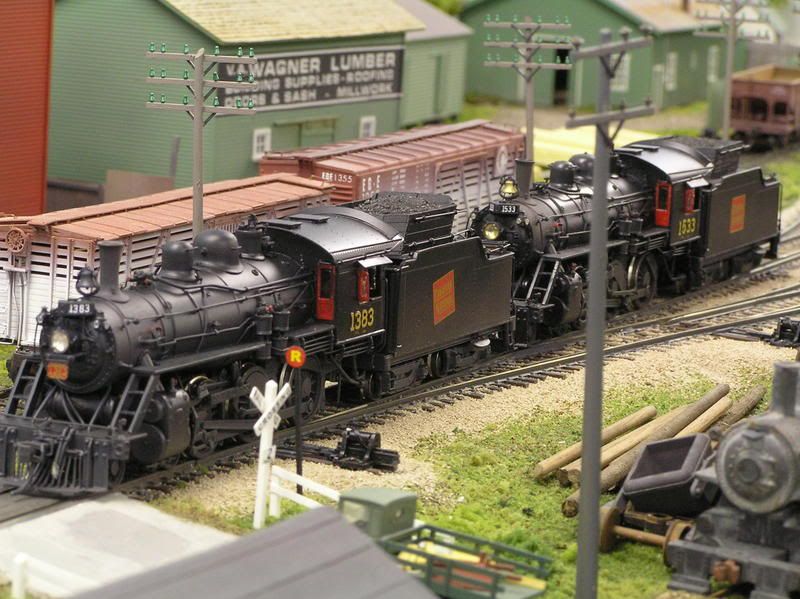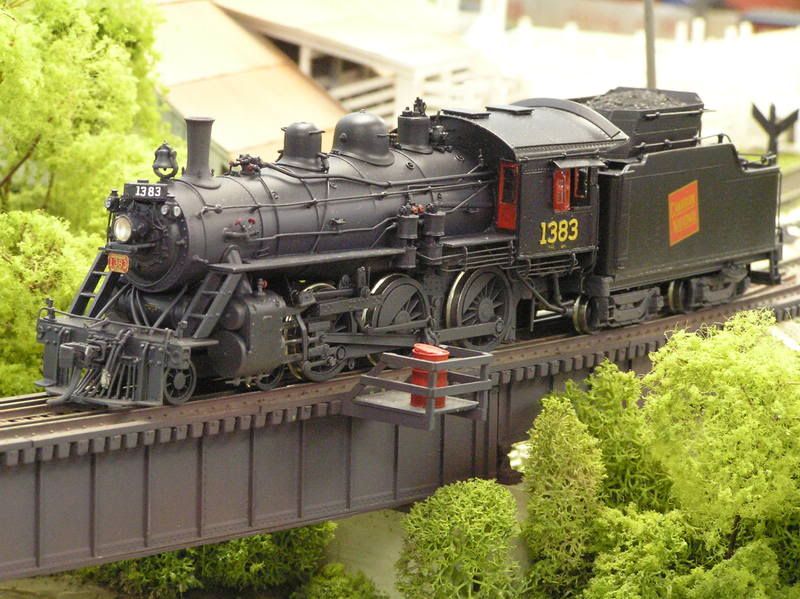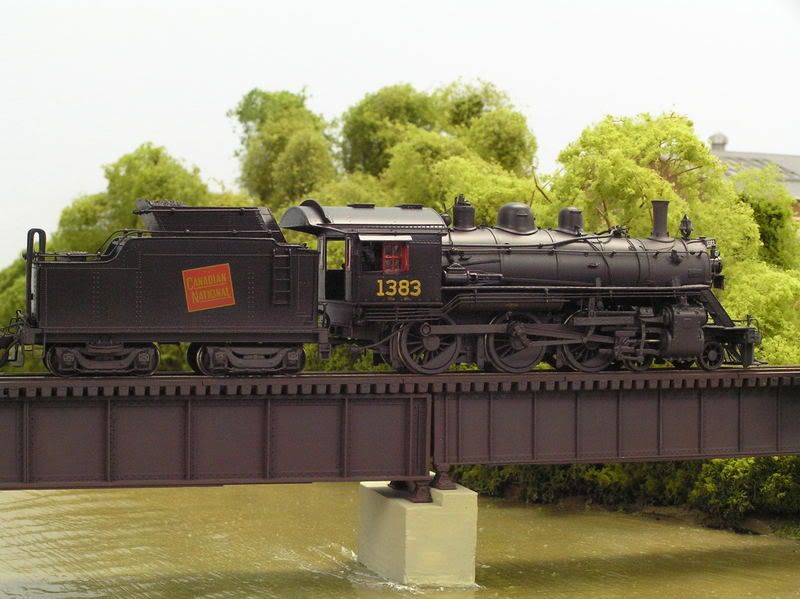...and if not at the Ritz, at least it's an improvement over their usual duties of pulling way freights. It's an excursion train, out of Mount Forest, for the employees of the Tuckett Tobacco Company, and these two old girls are all dolled-up for the occasion. As the train rolls through the summer haze at Elfrida, on the tracks of the Erie Northshore, they have their train of five heavyweight coaches well in hand.

Chronically short of motive power, both the host road and its parents, the EG&E and Grand Valley, have supplied the coaches but have had to turn to interchange partner CNR for the "oomph". Even though these two locos are just loafing as they clatter through town, they'll need every ounce of their combined tractive effort of 56,000 lbs. for the return trip, which is almost entirely uphill, at 2.5% or worse.
For now, though, the head end crews enjoy the light breeze, as their charges rumble over the bridge at Chippawa Creek...

....the noise momentarily silencing the birds and cicadas, and startling the fish in the creek below:

The visitors roll on, slipping across Indian Line. Lead loco 1533, an H-6-d out of Montreal Locomotive Works in 1910, has been recently renumbered (nee Canadian Northern 1325) and will outlive her companion by many years, surviving to this day:

A motorist, waiting for the train to pass, is surprised to see a second loco, and surprised even more so when the coaches glide past. At least the train is short.

Still rolling downgrade, both stacks are clear, while back in the coaches, non-air conditioned, the heat and humidity have muted the conversations of the holidaying passengers:

The engine crews, meanwhile, tend to their business as the scenery rolls by.

As the locos burst out of the trees and onto the Maitland River bridge, the chatter in the coaches springs to life, revived by the scent of water in the breeze. The Lowbanks station is only minutes away, where buses wait to whisk the revellers to the sandy beaches and amusement park on the Lake Erie shore line.

With throttles closed, and a light reduction on the brake pipe to stretch the slack, the train nears the Lowbanks' end of the bridge. After dropping the passengers, the crew will need to turn and service their locos before heading for a break.

Turned and serviced, the locos sit patiently in the summer haze, the thump of an air pump occasionally interrupting the quiet. The crews will have little to do until train time, and while away the hours renewing acquaintances with old friends at the station.

The 1383, an H-6-g, is a 1912 graduate of MLW, and despite being the younger sister, will be scrapped in October of 1961. She'll lead on the return trip later today.

While the prototypes of both of these locos had similar original specs (63" drivers, 22"x26" cylinders, and operated at 200 lbs. pressure) yielding a tractive effort of 30,000 lbs., all H-6 locos were given a rating of 28,000 lbs, in 1930, regardless of actual specifications, to make the rating uniform for the entire class. The models, though, do differ slightly, with the 1533 (owned by my good friend cn nutbar) unable to move this 5 car train by itself for the return (uphill) trip. I recently purchased the 1383, used, and while it was generally in good condition, it was missing the lead weight from its boiler. Rather than disassemble Mister Nutbar's loco to check what size was required, I simply cast a new weight to fit the available space. After a little detailing work and some minor repairs, I repainted the loco and tender, then put both locos into service for this thread. It seemed logical to me that a single loco of this size would be adequate for the down bound trip, but unlikely that either the prototype or its model could handle such a train on the uphill journey. To my (pleasant):-D surprise, though, the 1383 easily handled the 5 heavyweights, and I daresay could have handled even a couple more. Upon weighing the two (loco and tender, in running form with a full coal load), I discovered the 1533 to weigh 17.5 oz., while the 1383 tipped the scales at 20.5 oz. It must have been all that extra weight that lead to the old girl's early demise.
It must have been all that extra weight that lead to the old girl's early demise. 
 :-D:-D
:-D:-D
My apologies to all for the quality of the photos (I'm a bit out of practice ops: ) and especially for the size: I had to re-size all to get them to go into the Gallery, which is currently experiencing some teething pains.
ops: ) and especially for the size: I had to re-size all to get them to go into the Gallery, which is currently experiencing some teething pains. 
Wayne

Chronically short of motive power, both the host road and its parents, the EG&E and Grand Valley, have supplied the coaches but have had to turn to interchange partner CNR for the "oomph". Even though these two locos are just loafing as they clatter through town, they'll need every ounce of their combined tractive effort of 56,000 lbs. for the return trip, which is almost entirely uphill, at 2.5% or worse.
For now, though, the head end crews enjoy the light breeze, as their charges rumble over the bridge at Chippawa Creek...

....the noise momentarily silencing the birds and cicadas, and startling the fish in the creek below:

The visitors roll on, slipping across Indian Line. Lead loco 1533, an H-6-d out of Montreal Locomotive Works in 1910, has been recently renumbered (nee Canadian Northern 1325) and will outlive her companion by many years, surviving to this day:

A motorist, waiting for the train to pass, is surprised to see a second loco, and surprised even more so when the coaches glide past. At least the train is short.

Still rolling downgrade, both stacks are clear, while back in the coaches, non-air conditioned, the heat and humidity have muted the conversations of the holidaying passengers:

The engine crews, meanwhile, tend to their business as the scenery rolls by.

As the locos burst out of the trees and onto the Maitland River bridge, the chatter in the coaches springs to life, revived by the scent of water in the breeze. The Lowbanks station is only minutes away, where buses wait to whisk the revellers to the sandy beaches and amusement park on the Lake Erie shore line.

With throttles closed, and a light reduction on the brake pipe to stretch the slack, the train nears the Lowbanks' end of the bridge. After dropping the passengers, the crew will need to turn and service their locos before heading for a break.

Turned and serviced, the locos sit patiently in the summer haze, the thump of an air pump occasionally interrupting the quiet. The crews will have little to do until train time, and while away the hours renewing acquaintances with old friends at the station.

The 1383, an H-6-g, is a 1912 graduate of MLW, and despite being the younger sister, will be scrapped in October of 1961. She'll lead on the return trip later today.

While the prototypes of both of these locos had similar original specs (63" drivers, 22"x26" cylinders, and operated at 200 lbs. pressure) yielding a tractive effort of 30,000 lbs., all H-6 locos were given a rating of 28,000 lbs, in 1930, regardless of actual specifications, to make the rating uniform for the entire class. The models, though, do differ slightly, with the 1533 (owned by my good friend cn nutbar) unable to move this 5 car train by itself for the return (uphill) trip. I recently purchased the 1383, used, and while it was generally in good condition, it was missing the lead weight from its boiler. Rather than disassemble Mister Nutbar's loco to check what size was required, I simply cast a new weight to fit the available space. After a little detailing work and some minor repairs, I repainted the loco and tender, then put both locos into service for this thread. It seemed logical to me that a single loco of this size would be adequate for the down bound trip, but unlikely that either the prototype or its model could handle such a train on the uphill journey. To my (pleasant):-D surprise, though, the 1383 easily handled the 5 heavyweights, and I daresay could have handled even a couple more. Upon weighing the two (loco and tender, in running form with a full coal load), I discovered the 1533 to weigh 17.5 oz., while the 1383 tipped the scales at 20.5 oz.
My apologies to all for the quality of the photos (I'm a bit out of practice
Wayne







